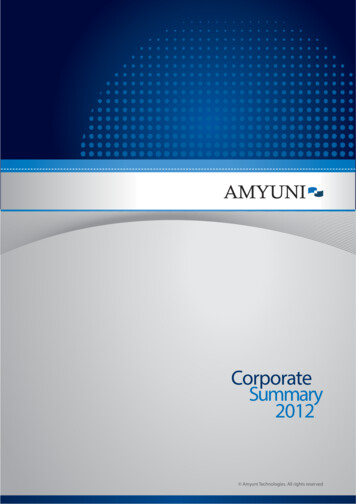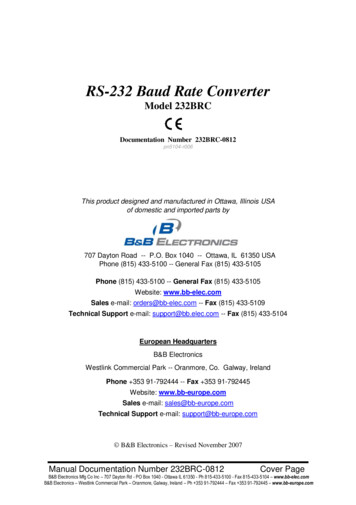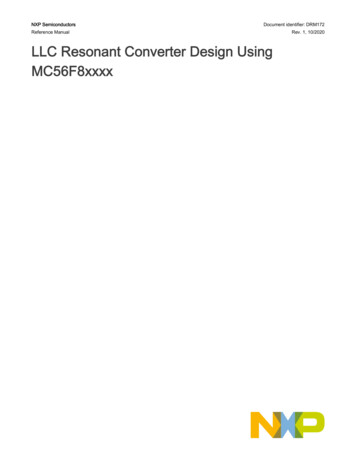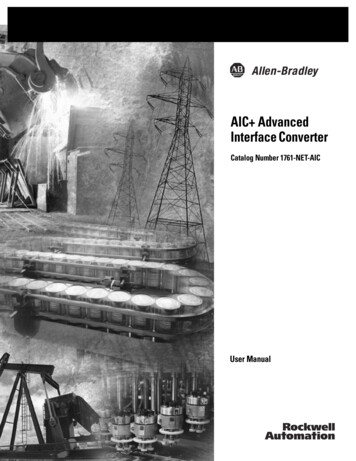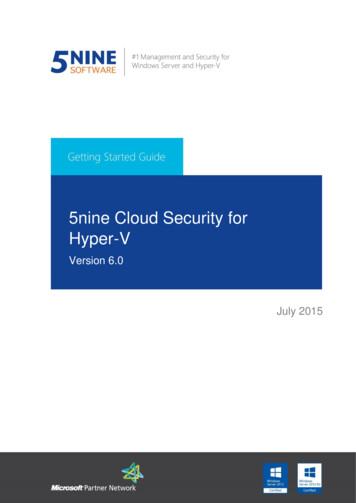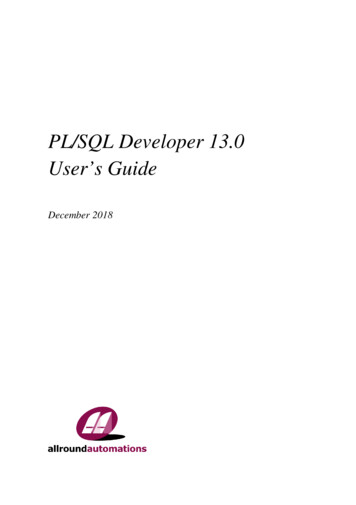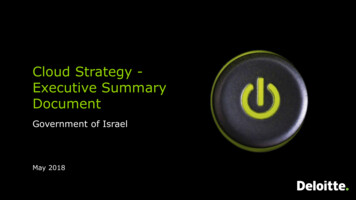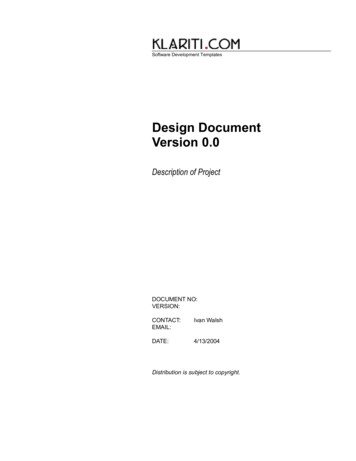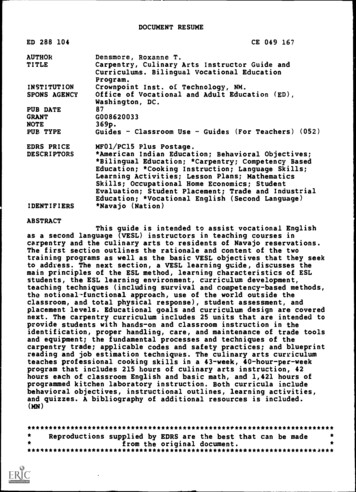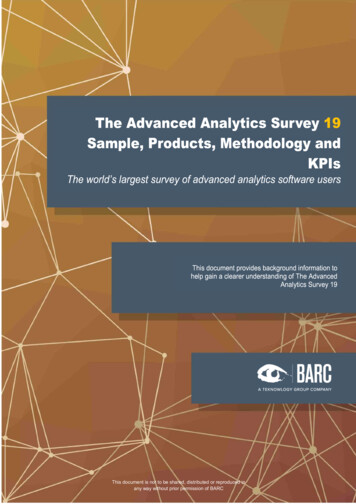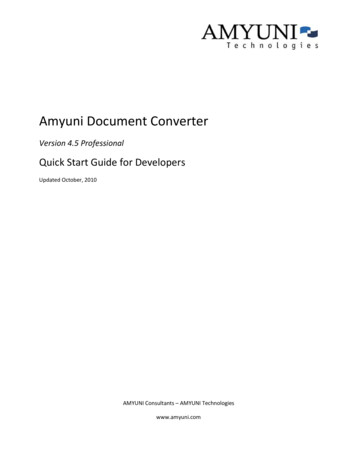
Transcription
Amyuni Document ConverterVersion 4.5 ProfessionalQuick Start Guide for DevelopersUpdated October, 2010AMYUNI Consultants – AMYUNI Technologieswww.amyuni.com
ContentsLegal Information . 3Important Note for developers . 3Acknowledgments . 3New In Version 4.5 . 4Introduction. 5Using the Developer Version of the Amyuni Document Converter . 7Note about Legacy Platforms . 7Sample . 7Important Note for Version 4.5 . 8DLL Interface. 9ActiveX Interface . 9Note to VB6 Users. 10Note on Function Calls. 11ActiveX Methods . 11DLL Methods. 11Links to Support and Documentation:. 12Online Documentation: . 12Frequently Asked Questions:. 12Technical Notes: . 12User forum:. 12Posting questions to our technical support staff: . 12
Legal InformationInformation in this document is subject to change without notice and does not represent a commitment on thepart of AMYUNI Technologies. The software described in this document is provided under a license agreement ornondisclosure agreement.The software may be used or copied only in accordance with the terms of the agreement. It is against the law tocopy the software on any medium except as specifically allowed in the license or nondisclosure agreement.The licensee may make one copy of the software for backup purposes. No part of this guide may be reproducedor transmitted in any form or by any means, electronic or mechanical, including photocopying, recording, orinformation storage and retrieval systems, for any purpose other than the licensee’s personal use, withoutexpress written permission of AMYUNI Technologies.Copyright 2000-2010, AMYUNI Consultants – AMYUNI Technologies. All rights reserved.Amyuni and the Amyuni logo are trademarks of Amyuni Technologies Inc. Adobe, the Adobe logo, Acrobat, theAcrobat logo are trademarks of Adobe Systems Incorporated.Microsoft, the Microsoft logo, Microsoft Windows, Microsoft Windows NT and their logos are trademarks ofMicrosoft Corporation.All other trademarks are the property of their respective owners.Important Note for developersThe activation code that is provided to you by Amyuni should be kept confidential and not be revealed toend-users, even in this case where the developer’s products are sub-licensed to other developers.AcknowledgmentsThis software uses the deflate algorithm developed by Jean-loup Gailly jloup@gzip.org)(and Mark Adler(madler@alumni.caltech.edu). This software is also based in part on the work of the Independent JPEG Group andon parts of the FreeType library.3
New In Version 4.5 WHQL Testing and Certification for 32 and 64-bit Windows 2008 and Windows 7 64-bit SDK improves performance and compatibility with 64-bit applications Preview window integrated within the SDK does not require launching external applications Improved performance and reliability for post-processing of PDF documents such as Appending,Merging, Watermarking or Printing Improved conversion of EPS objects embedded into Office documents using an updated Postscript 2interpreter Improved marked content generation for customizing the resulting PDF Direct conversion of TIFF to PDF through the SDK. OCR module can be purchased separately as an addon to PDF Converter OEM licensees are now offered the ability to customize the user-interface and add their ownconfiguration tabs to the printer4
IntroductionThis manual is a supplement to the Amyuni Document Converter series of products. These include the PDF,HTML, RTF, Excel, TIFF, and JPeg Converter products or any combination of these formats. Each of these productsships with a user’s manual that describes the overall operation of the product. The developer should be familiarwith the operation of the specific product that he or she is using before reading the developer’s manual.All Amyuni Document Converter products share the same interface DLL named the “Common Driver Interface”.This interface resides in a DLL named CDINTF450.DLL that should be in the system or system32 directory.CDINTF450 provides the developer with three calling conventions. Depending on their development platform andprogramming habits, developers might chose one these three interfaces: A standard DLL interface. An ActiveX interface. A .NET Managed Code Interface.5
Using the Developer Version of the Document Converter ProductsThe developer version of the Amyuni Document Converter products is a special version of these products that canbe distributed with the developers’ applications without paying any additional royalties to Amyuni Technologies.By special version, we mean a version that: Does not need to be pre-installed on the client system (although recommended). Does not have any properties dialog box. Does not have any "File Save As" dialog box.All printer configurations, file destinations and options settings should be done programmatically by the mainapplication.
Using the Developer Version of the Amyuni Document ConverterThe following is a step-by-step procedure for using the developer version of the Amyuni Converter.1. Copy all distributable files to the application’s main directoryThe application’s main directory is usually where the executable file is located. The list of distributablefiles is as follows:Operating SystemsDynamic Link Libraries (DLLs)Common to all versionsinstall.exe, acfpdf.txt, amyuni.inf,atpdf450.catWindows 32-bitscdintf.dll, acfpdfu.dll, acfpdfui.dllWindows 64-bits, AMD or Intel64 basedcdintf64.dll, acfpdfuamd64.dll,acfpdfuiamd64.dllNote about Legacy PlatformsWindows 98/Me, NT4 and IA64 drivers have not been updated since version 2.5. These drivers are notincluded with the products but can be downloaded separately from:http://www.amyuni.com/downloads/legacy drivers.zip2. Initialize the Document Converter printer on the end-user’s system.Method 1 (Recommended)By launching Install.exe during the installation of the main application. Install.exe should be launchedfollowed by a printer name specific to the developer’s company or application:Command Line ParametersDescription-s(Optional) Runs in silent modePrinter NameName of printer as it will appear on the listof system printers-NLicense Name-CActivation Code-OPort name – Install printer attached to aspecific port-lDo not generate a log fileAll command line parameters should be surrounded by double quotes when they contain spaces.SampleInstall -s "My Company Printer" -n "Evaluation Developer License" -c "07ABCDA0A12301230123".Method 2By calling PDFDriverInit at the initialisation of the application. The documentation for PDFDriverInitprovides details about how to use this function to initialize the printer and activate it.7
3. (Optional) When using the DLL interface of CDIntf, copy CDIntf.dll or CDIntf64.dll to your application’sfolder. This will guarantee that your version of this DLL will not be overwritten by other developersinstalling a different version.4. (Optional) Register the CDIntf ActiveX. When using the ActiveX interface, the ActiveX control should beregistered in the system by calling RegSvr32 from your application’s directory: REGSVR32 CDINTF.DLLor REGSVR32 CDINTF64.DLL.CDIntf can be used through the DLL interface without the need for registering or creating ActiveXs.Important Note for Version 4.5For 32-bit applications running on a 64-bit OS, the application is responsible of registering the 32-bitActiveX control using the 32-bit version of REGSVR32 or through the call to the DllRegisterServer API.This is because the 64-bit printer driver is not capable of registering 32-bit ActiveX controls and will onlyregister the 64-bit CDIntf64.dll.5. Initialize the printer at start-up of your application by callingDriverInit followed by the printer name.6. Export to the format of your choice by printing from your application. When the user chooses theexport function of your application to generate a PDF, HTML, RTF, JPEG, TIFF or Excel file, you need toset up the output file name using SetDefaultFileName, the file generation options usingSetFileNameOptions( NoPrompt UseFileName ) and print to the "My Company Printer" as youwould do when printing to any other printer.The developer can be in one of three situations:oThe developer licensed a product that generates only one format, e.g. PDF only or RTF only. In thiscase, the printer will generate the right format without any specific option to set.oThe developer licensed a product that generates multiple formats including PDF, e.g. PDF and RTF.In this case, to export to either RTF, HTML, JPEG, TIFF or Excel, the corresponding option should beset in the call to SetFileNameOptions. The PDF file will be generated in all cases and should bedeleted by the developer if not needed. There is no method to have the Converter generate anRTF/HTML/JPEG/TIFF/Excel file only without generating a PDF.oThe developer licensed a product that generates multiple formats excluding PDF, e.g. RTF andHTML. In this case, to export to either RTF, HTML, the corresponding option should be set in thecall to SetFileNameOptions. A temporary file will be generated in these cases and will be deletedby the printer when the print job is finished.7. Restore the printer to its previous setting. When printing is over, the developer needs to callSetFileNameOptions (0) to prevent other applications or users from overwriting the file that has justbeen generated from the application.8. Uninitialize the printer before exiting. Before exiting the application, the DriverEnd function should becalled. This function will remove the printer if installed usingPDFDriverInit, otherwise it will simplydisconnect from the printer.Important Note for developersTo avoid confusion with other applications and with the single-user versions of the DocumentConverter products, developers are required to use a printer name specific to their application orcompany. Using the default printer names of "Amyuni Document Converter" or "Amyuni PDFConverter" is not allowed.The activation code that is provided to you by Amyuni should be keptconfidential and not be revealed to end-users, even in this case where the developer’s products aresub-licensed to other developers.8
DLL InterfaceBefore using the DLL interface of CDINTF450, the C or C developer might need to download the header andlibrary files The zip file also contains the latest version of CDIntf450.DLL.The library file is compatible with Visual Studio 2005 and higher. When using other compilers such as BorlandC , the developer needs to import the library from the DLL instead of using the library from our “downloads”section.Visual Basic users can import the included CDIntf450.txt file to get the entire constant and function declarationsof CDIntf450. VB users are encouraged however to use the ActiveX interface as it remains more versatile andeasier to use from within VB.ActiveX InterfaceBefore using the Common Driver Interface as an ActiveX component from any ActiveX aware application, thedeveloper should register the DLL in the system by calling RegSvr32 from the location where this DLL is installed:Regsvr32 CDINTF450.DLLThis is done automatically by the default installation procedure of any of the document converter product.The CDIntf control starting with version 4.5 has been renamed to CDIntfEx.CDIntfEx.4.5 to avoid confusion withthe previous versions. The control can either be created dynamically through code or placed on a form like anyother VB control. When placed on a form, the control remains invisible at run time.To dynamically create the CDIntfEx object, the CDINTF450 DLL should first be imported into the project. Theprocedure is quite similar in all programming environments.Here is what it would look like in VB:9
To place the CDIntfEx control on a form, it should be imported into the project using the Project's Componentsmenu:It should then appear in the components toolbar as follows:Note to VB6 UsersVB6 users that had used previous versions of CDIntf or are trying to switch from dynamically createdobject to the visual component placed on a form, might receive the following error message from VB:If this happens, the control should be manually removed from the project by following these steps:1. Close the VB project2. Open the .VBP file using any text editor10
3. Locate and remove the line:Reference \WINDOWS\System32\cdintf.dll#CDIntf.4.Reload the project in VB and import the control.Note on Function CallsActiveX MethodsOn Success ActiveX methods will have a return relevant to their functionality. On failure, most ActiveX calls willraise an exception. The caller should properly catch any exceptions generated from a call to the ActiveX.If the library was not initialized properly, an exception will be thrown. To get extended error information, callGetLastErrorMsg.DLL MethodsOn Failure, most DLL functions will return zero (NULL). To get extended error information, call GetLastErrorMsg.On success, DLL methods that return a HANDLE will return a handle for the virtual printer that will be used as anargument for other method calls. The hPrinter handle returned by the functions is not to be confused with thehPrinter handle returned by the Windows API OpenPrinter and CreatePrinter functions.11
Links to Support and Documentation:If you have any questions or problems with our products, the following resources are available to you throughour web site:Online per Documentation.htm#index.htmFrequently Asked p?f 18Technical notes/User forum:http://www.amyuni.com/forum/index.phpPosting questions to our technical support We also provide some additional tools that can be downloaded free of charge and used with the PDF Converterproduct. These tools are available at:http://www.amyuni.com/en/resources/freetools/12
Converter products, developers are required to use a printer name specific to their application or company. Using the default printer names of "Amyuni Document Converter" or "Amyuni PDF Converter" is not allowed.The activat
